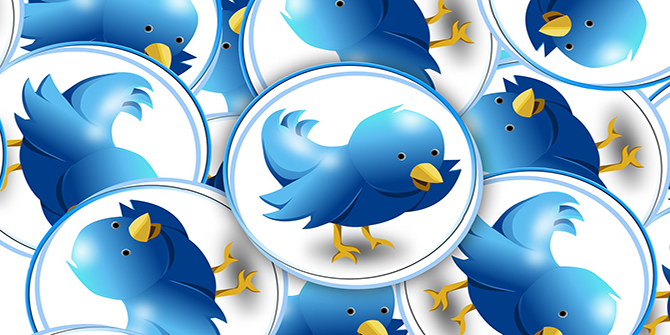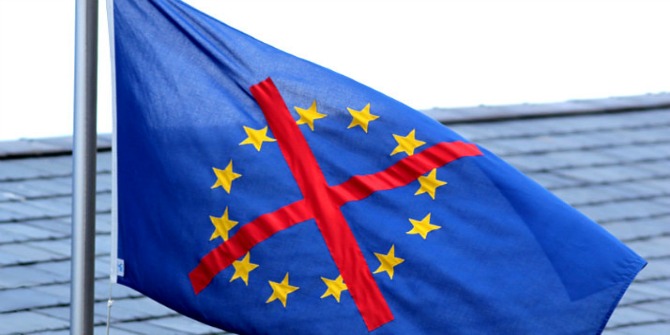 A healthy democracy requires a watchdog in its press — not an ‘attackdog’, ‘snarling’ and ‘barking’ at an elected politician. Yet this is how Jeremy Corbyn is being treated by the media, explains Brooks DeCillia. He outlines the findings of LSE research that show how the Leader of the Opposition is being delegitimased by the British press through distortion, ridicule, and association with terrorism.
A healthy democracy requires a watchdog in its press — not an ‘attackdog’, ‘snarling’ and ‘barking’ at an elected politician. Yet this is how Jeremy Corbyn is being treated by the media, explains Brooks DeCillia. He outlines the findings of LSE research that show how the Leader of the Opposition is being delegitimased by the British press through distortion, ridicule, and association with terrorism.
“Pacifist Corbyn refuses to bow,” screamed The Sun’s headline, ridiculing the Labour leader for his apparent lack of deference to the war dead during Remembrance Day ceremonies in 2015. Twitter — and the right-wing outrage media machine — exploded moments after Jeremy Corbyn stepped back from placing a wreath reading: “In memory of the fallen in all wars, let us resolve to create a world of peace.” The Sun dubbed it a “snub.”
Corbyn, dressed in black and wearing a red poppy, did, of course, bend subtly after laying the wreath. But his bow wasn’t sufficient genuflection for many in the press. The Telegraph quoted an etiquette expert claiming that he didn’t bend deep enough while The Independent stressed that concerns over Corbyn’s “decision not to sing the National Anthem at a Battle of Britain memorial service” a month earlier heightened scrutiny of his performance at the war memorial.
Much of this news coverage — conspicuously — ignored that Corbyn stayed behind after the ceremonies to pay his respects directly to veterans while other politicians quickly retreated to a VIP lunch. Photos show Corbyn — away from the cameras — applauding as former soldiers marched past the Cenotaph. After the ceremony, Corbyn also attended another Remembrance Day commemoration in his constituency.
Clearly, the Labour leader has a media problem: he is the target of scorn and ridicule in so much of it. More than 50 per cent of news reporting about Corbyn is negative or blatantly antagonistic (Figure 1). That’s news coverage — the supposed bastion of journalistic neutrality. And, astonishingly, he gets blamed for his “toxic relationship with the media.” It all reads like blaming the victim of a crime.

And while the Independent Press Standards Organization (IPSO) insists that its members have a “duty to maintain the highest professional standards”, three in ten pieces in the British print media mock the leader of the opposition, scoffing at his ideas, policies, history — and, alarmingly, even his looks. And although again according to the IPSO, a healthy democracy requires a press that is “free to editorialise and campaign”, the Leader of the Opposition and long-serving MP for Islington North frequently gets reduced to the journalistic shorthand of a caricature. He is often portrayed as a clown-like figure, mocked as the ‘Jezster’ or derided as the comic political equivalent of the child-like TV sitcom character Mr. Bean with tabloid media referring to him as ‘Mr. Corbean’ repeatedly.
And so much of the news media coverage of the Labour leader is maliciously personal. A week after his election as leader, The Daily Telegraph artfully condensed all of its sneering criticisms into a sentence, describing him as “a rather dreary bearded fellow who takes pictures of manhole covers as a hobby, doesn’t drink alcohol or eat meat, and wears shorts teamed with long dark socks exposing an expanse of pale, hairy English shin.”
Repeatedly, commentary suggests that Corbyn’s sartorial and lifestyle choices make him seem weird — and decidedly unelectable. The Telegraph also mocked Corbyn’s appearance, noting that his pants and jacket did not match at the memorial service at St Paul’s Cathedral where he took so much media grief for not singing the national anthem. “The top button of his shirt was undone,” opined the news story. “He looked like a lecturer who’d woken late, got dressed in the dark, then loosened his collar to recover from the mad panting dash to the bus stop.”
Our analysis of media coverage of Corbyn found many startling findings. First, Corbyn repeatedly gets portrayed as a political transgressor who isn’t playing ‘the game’ in the way the media and the political establishment expects. While it is the role of journalists to be critical and fulfil a monitorial role, in the case of Corbyn the media transgressed into a vile attack dog journalism, a democracy unworthy.
Second, the prevalence of a negative and antagonistic tone towards Corbyn is quite staggering. During our period of analysis (September-November 2015), 54 per cent of all news articles were either negative or antagonistic towards Corbyn, which rises to 67 per cent for opinion pieces and editorials. Both figures are very high – especially for news reporting which, from a normative perspective, we would expect to be factual, impartial, and balanced.
There is obviously an ideological bias as well, with the right-wing media being more acerbic, more scornful, mocking gleefully, and attacking Corbyn on a personal level. Part of this is the amplification of the civil war within Labour whereby the anti-Corbyn Labour sources tend to outweigh the pro-Corbyn ones (Figure 2). This is especially pronounced in The Daily Express and in The Daily Telegraph.
But there is also a lot of negativity towards him in the left-wing press, considering him too left, unrealistic, and unelectable. In The Independent and The Daily Mirror, for example, discrepancies can also be observed with regards to the use of pro-Corbyn and anti-Corbyn Labour sources.

Finally, the most problematic finding is that the British media has actively delegitimised the elected leader of the UK’s largest party. This was done through scorn and personal attacks, but above all by strongly associating him with condoning terrorism.
Almost 10 per cent of the articles relating to Corbyn had a reference to Iran, Hamas, Hezbollah, IRA and/or terrorism in general (Figure 3). Linked to this was the strong depiction of Corbyn or his ideas as dangerous – a danger frame that was not only fed by journalists (9 per cent), but also by the Tories and Cameron (4 per cent), and by anti-Corbyn Labour sources (6 per cent). And although Corbyn’s own views are missing in more than half of the articles on him, when his views are reproduced they are very often taken out of context (22 per cent).

Corbyn clearly appears different from the generations of cookie cutter politicians the UK has grown used to. What UK newspapers have done — and continue to do — through depictions of the Labour leader has grown beyond a mere political question: it now also raises ethical and democratic ones because Corbyn was elected by Labour members. If newspapers care so much about public service and their readers, they might want to show them some respect — and treat Corbyn with respect and fairness.
____
Note: the full report on which this article draws on is available here.
 Brooks DeCillia is a PhD candidate at the LSE’s Media & Communications Department. Before coming to LSE, Brooks worked as a journalist and public broadcaster.
Brooks DeCillia is a PhD candidate at the LSE’s Media & Communications Department. Before coming to LSE, Brooks worked as a journalist and public broadcaster.








What is wrong with people commenting here? The article makes clear that there is an anti-Corbyn bias and all you can do is add to it? Jeremy Corbyn represents an idea,it is an idea of fairness and equality,support for public services and workers rights and it is supported by over 500,000 members.
So this report shows that the Guardian, for instance, is on balance not just balanced, but even marginally Pro-Corbyn.
This counters the incredible sabotage campaign by Corbyn fanatics against the Guardian.
A similar report into the broadcast media coverage would exonerate the BBC even more. But Corbynite dogma seems even more determined to destroy the BBC than Murdoch is.
Instead of using Billionaire bias as a way of illustrating the genuine problem, Corbysoxers have simply used the BBC as a permanent Hate-Fest.
Report shows <20% of guardian reports positive; meanwhile 30% critical or antagonistic toward Corbyn.
Rob: "this shows guardian is pro Corbyn".
The white bar means *neutral* Rob, not pro Corbyn. Don't gaslight people who have observed the Guardian following the zombie herd and doing a hatchet job on JC.
And you have only just discovered this?
You have been asleeep at the wheel for how long.?????????
OMG
OMG!
“The leadership usually couldn’t get a press release out on time…..” Oh crickey, better call Tim Allan, or if all else fails, Bob Geldolf.
“Against that background it’s very difficult to build a case for traditional newspapers having a crucial role in shaping public opinion,….” And in this sentence, you will find exactly the kind of spin and ommission that might be tyically parroted by the BBC or other mainstream media,that is *controlled* by Murdoch or a hereditary Nom Dom somewhere.. You aren’t that ex-employeee of Rupert Murdoch by any chance, who heads BBC news are you ? Perhaps your’e a trolley collector then, at the major supermarket down the road, who positions the newspapers in the morning and their juicy headlines as you walk through the automatic doors. Maybe your’e the lady who works on the till at the petrol station then, where you have to pass by another headline on your way to pay for fuel. Oh that headline comes from a local newspaper does it ? You mean Archant Group are local ? surely not HM Lord Lieutenant of Norfolk.
Are there stats for other Opposition leaders or senior politicians?
The data are interesting, but without a comparison, they don’t tell us how differently from other politicians he is treated.
I like this article but it makes me so upset that the media can influence democracy so much. What can be Done?
Kieran Wright’s comments are spot on. It’s a pity the study wasn’t of the media more generally rather than of one decreasingly relevant and arguably unrepresentative part of it.
Kieran Wright’s comments are sopt on. It’s a pity the study wasn’t on media coverage rather than on a narrow corner of it.
We in the USA recognize the attacks by the neoliberal establishment and its’ media wing. We have seen it in the Bernie Sanders candidacy for the past year. The right wing oligarchs hate and despise leaders who do not subscribe to their neocon war making and destruction of the social safety net in favor of profit making industries.
Corbyn is different. That makes him one of ‘them’ in the neoliberal game of opposing and ridiculing, excluding and denying the very right of these ‘others’ to exist, let alone share power with them.
Anyone who thinks that criticism of Corbyn is confined to the ranks of “the establishment”, “neo liberals” or “right wing oligarchs” isn’t seeing the full picture. There are plenty of examples of people who share his political outlook, and were willing to work with him to help him achieve his aims, but concluded that his basic lack of leadership skills made that a pointless excecise. Witness the examples I’ve posted elsewhere on this page, and the speech Corbyn’s former transport spokesperson recently gave to her constituency party detailing his flaws.
“..were willing to work with him ….but concluded that his basic lack of leadeship skills made that a pointless exercise.” I assume you are refering to Richard Murphy as one such person, as I see you have noted Richard’s statements elsewhere. But you do know Richard defended the smearing PR campaign of Corbyn and his supporters. You do know that I hope. Richard claims it’s all part of politics and Jeremy should just accept it. But if smearing and owning the ability to pay off PR companies isn’t accetable in the view of trade unions, most of the public (who have not the funds to compete in this dirty political tactic) and is Corbyn’s core campaign message: for cleaner politics, isn’t it then just the case, that Jeremy Corbyn and Richard Murphys distancing, is a result of exceptionally good judgement of character on behalf of the Labour Party leader, and furthermore, it was this undoubtedly strong leadership, that was also shown in foiling the Chicken Coup Plotters as they “hatched” their plot from day one.
Let’s get specific.
For a start, why no Commons alliance with the SNP a year ago?
Corbyn seems determined not to build bridges with other progressive parties.
If he had demonstrated a unified reformist agenda with European groups during the referendum, we wouldn’t be in this mess now – and his own personal image would have been boosted to Statesman level – and Labour wouldn’t have torn itself apart for 3 months.
Maybe Corbyn wants a mess.
The significance of studies such as that outlined above is substantially undermined by the ongoing decline in the significance of traditional newspapers as a news source for the vast majority of the public. The best recent research on the subject is OFCOM’s 2015 report on news consumption. It found that the Sun and the Mail each reach 6 percent of the U.K. adult population; down from 11 and 9 per cent respectively in 2014. Both have the greatest reach of any traditional newspaper. As regards online papers only the Mail and the Guardian websites feature in the top 20 news sources, both with a reach of 4 per cent. Against that background it’s very difficult to build a case for traditional newspapers having a crucial role in shaping public opinion; a fact that should lead anyone to question the value of a study that confines itself to analysing the output of those sources.
The Labour Party’s current difficulties cannot credibly be blamed on unfair coverage in a number of traditional newspapers. Criticism of the current Labour leadership exists far beyond the confines of the mainstream media, and much of it raises questions as much about basic competence and lack of policy as much as having the wrong policies.
Thangam Debbonaire (Lab, Bristol W) was perfectly willing to serve in a Corbyn shadow cabinet, yet posted on Facebook yesterday a damning account of her experience of the current leadership. Richard Murphy (tax expert who was willing to assist the current leadership in formulating policy) writes this in his blog: “The leadership wasn’t confusing as much as just silent. There was no policy direction, no messaging, no direction, no co-ordination, no nothing. Shadow ministers appeared to have been left with no direction as to what to do. It was shambolic. The leadership usually couldn’t even get a press release out on time to meet print media deadlines and then complained they got no coverage”. “The same problem has been seen around Brexit and so many other issues. If Jeremy and John had known what they were doing these impasses would not have happened. The impression left is that they have created a movement that hates what’s happening in the world and can get really angry about it, but then has not a clue what to do about it”.